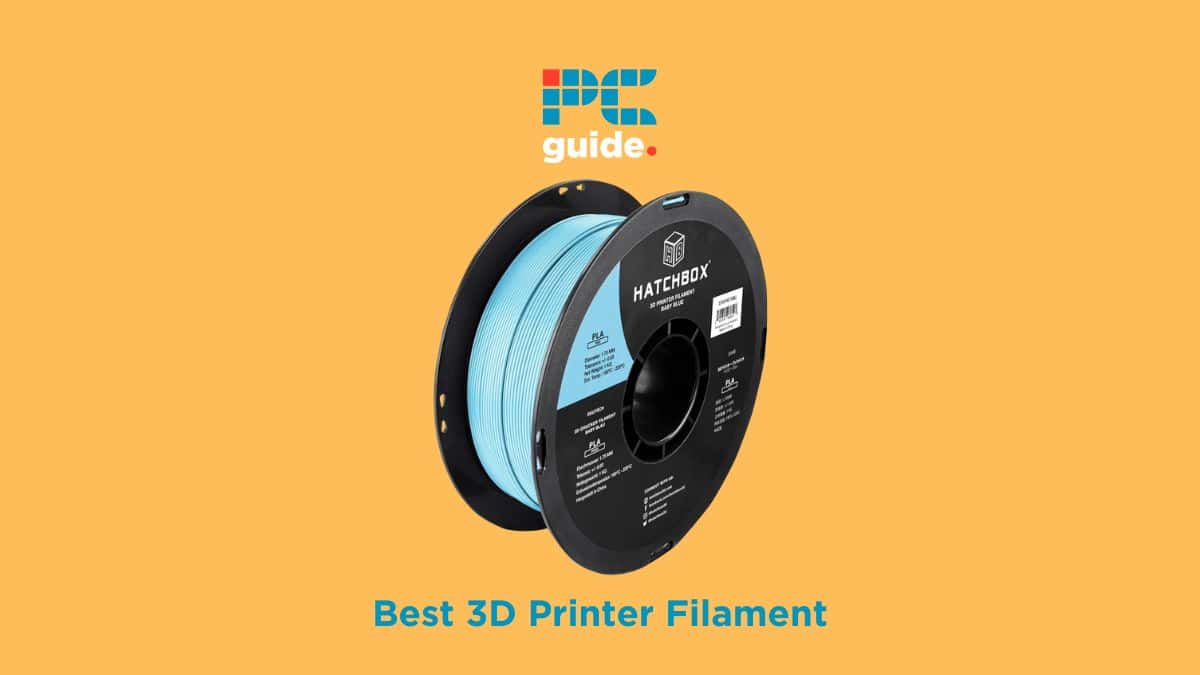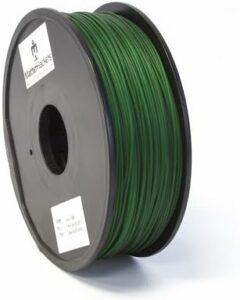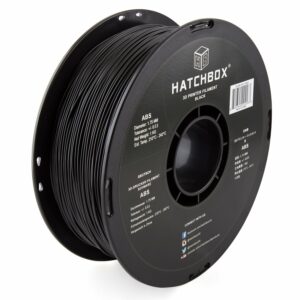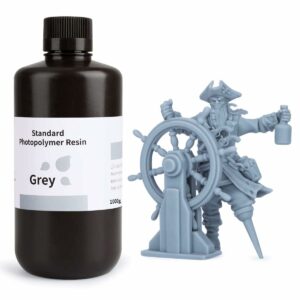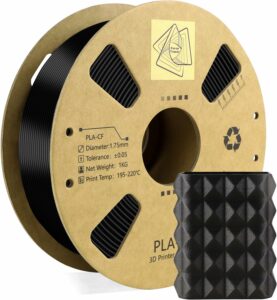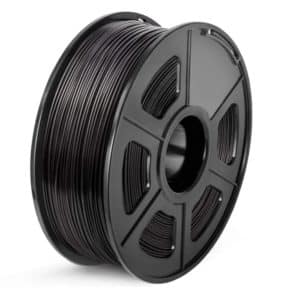Products at a Glance
How We Picked the Best 3D Printer Filament
As mentioned, 3D printing filament is as subjective as it comes: many users are perfectly content with the standard-issue spools that came with their 3D printer, whilst many businesses and traders require highly specific material in order to print with the desired effect. As such, our list is less a de facto ruling as a recommendation. We’ve selected filaments that are both common and widely available, whilst also being used for specific niches of 3D printing. We’ve also endeavored to find the best brand that manufactures the filament in question with high compatibility. Like with ink in a standard issue printer, compatibility can vary from manufacturer to manufacturer.
We’ve listed our four top picks for 3D printer filament below, across a range of budgets. Though these filaments aren’t all equal, they each have their respective advantages that make for great 3D printing options.
Product Reviews
- Low heat requirements - PETG is compatible with most 3D printers due to the similar composition as PLA.
- High tensile strength - PETG is easier to mold but more rigid once shaped, for more durable prints.
- Limited print speed and temperature - exceeding the recommended print speed and print temperature can make for blemishes on designs.
- Softer surface - though the shape is rigid once formed, it's still soft and malleable: PETG is a primary material in water bottles, for frame-of-reference.
For those looking to experiment with new filament types, we highly recommend PETG as a starting point. Polyethylene terephthalate glycol, as it’s otherwise known, is a high-strength filament which is capable of more dextrous prints under similar conditions to PLA. PETG also doesn’t produce fumes, which can make it a safe 3D printing material for kids or printing with open-frame printers. We’ve chosen MatterHackers’ range of PETG as our top choice today, as we found the value-for-money correlated well with the admittedly higher price.
MatterHackers’ PETG produces smooth end results with little to no ridging. Thanks to the lower temperature requirements, its much quicker and easier to form shapes – and with a much lower chance of bubbles forming. However, be sure to keep your 3D printer within the recommended guidelines, as PETG can warp or blemish at higher print speeds. Once it’s set, PETG is more wear-resistant than PLA, making it a sterling alternative. Whilst the material is more expensive by the spool than other brand alternatives, MatterHackers’ PETG is a high-quality option that comes in a wide range of colors and textures – but all carry the same consistent quality overall.
- Highly durable - ABS is more element-resistant than PLA, meaning that prints are less likely to wear down over time.
- Good print bed adhesion - ABS prints remain rooted throughout the printing process, but are easy to remove once complete.
- Emits fumes - ABS is toxic in many forms, meaning that it's fumes can be dangerous to inhale.
- High temperature requirements - not all 3D printers are capable of reaching the temperatures needed to extrude ABS.
Acrylonitrile butadiene styrene, or ABS, is another great alternative to PLA that provides added durability whilst actually being lighter than other thermoset polymers. So long as you have an appropriate ABS 3D printer capable of reaching the required high temperatures, you can create long-lasting prints with smooth finishes. Hatchbox is our choice manufacturer for the best median of price and quality, with their range of ABS providing stellar print quality.
Prints are rendered brilliantly using ABS. Warping rarely, if ever, happens; and print bed adhesion is stellar. The only downside to using ABS for prints is that due to the high temperature requirements, the filament does emit fumes during printing – which is where an enclosed 3D printer may be the preferred type. Hatchbox ABS remains a stellar option, offering incredible print quality and heavy-duty rolls of filament – all at a great price.
- Accessible - SLA printing makes for smaller units and generally easier printing.
- Detailed small-scale prints - Resin is able to capture minute details in a model with ease thanks to its unique printing process.
- More involved post-printing process - resin prints require more cleaning and attention post-print than FDM prints.
- Results can be brittle - if not treated properly after printing, resin prints can easily break apart.
SLA printing, or Resin printing, is an increasingly popular and accessible alternative to 3D printing. Though it employs a different technique to standard FDM printing, there are still plenty of resin filaments to choose from on the market. We picked ELEGOO’s standard-issue resin as our standout pick: a bestseller that makes for sterling print results. Whether you’re looking to experiment with resin printing or are looking to improve your current setup and print better miniatures or components, ELEGOO’s resin range is the ideal solution.
Using a light-sensitive laser to cut shapes in the resin, SLA printing is a different, but equally valid beast. ELEGOO’s resin is highly consistent and responsive to SLA printers, though those coming from traditional 3D printing backgrounds may find the resin prints brittle upon arrival – as they require more treatment after printing than an FDM print. It’s easily overcome, however, and we recommend Resin filament as a unique alternative to standard 3D printing.
- Highly impact-resistant - carbon fiber is as precise as PLA whilst also being more rigid and impact-resistant.
- Reduced warping - 3D printing with carbon fiber can be done quickly with little-to-no shrinking or warping to the final product.
- Requires specialist nozzles - due to carbon fiber's unique composition, it requires a highly abrasion-resistant nozzle.
- Higher chance of clogging - even with the right nozzle, carbon fiber will still wear down your extruder over time, increasing the chance of clogging.
Carbon fiber is another 3D printer filament that often goes overlooked, but has grown in popularity in recent years. There are plenty of 3D printers for carbon fiber, as it’s one of the most compatible materials available. We’ve gone for Force Tracer’s spool of carbon fiber filament, which provides all the great results we expect from carbon fiber filament at a great price point.
With no shrinkage or deformation, carbon fiber is a stellar choice for supplementing PLA in your 3D printing setup. Force Tracer unspools easily and with incredibly low chance of warping, making this highly impact-resistant carbon fiber print even stronger. The only downside to using carbon fiber? You need specialist nozzles in order to print it – so whilst the printer compatibility is high, make sure that you have the right accessories. Once you’ve done so , you can unlock all the potential of printing with carbon fiber!
- High quality ABS
- Durable prints
- ABS is difficult to print with
- Smelly
As we mentioned earlier, Sunlu is an excellent international filament brand.
And like their PLA offering, their ABS line also offers excellent dimensional accuracy too, coming in at an impressive +/- 0.02 mm.
We love this filament because it produces very durable printouts compared to ones made with PLA.
It’s clog-free, bubble free, and easy to use. We just wish there were more colors to choose from!
Features and Considerations
If you’re struggling to choose your 3D printer filament for your next project, consider the following features:
Use Case
Obviously, what you’re planning to build will have an impact on what you build with. For food-safe prints for utensils such as cookie cutters, you’ll want a non-toxic filament. For components or long-lasting models, opt for a more durable filament. Naturally, the only person who can make this decision is you, so consider carefully in the initial planning stage.
Compatibility
The primary limiting factor on 3D printer filament is whether your printer is capable of reaching the required temperature for the filament. PETG and ABS are popular alternatives as they have similar heat requirements to PLA – which most 3D printers are designed for. Similarly, some filaments require specialist nozzles in order to extrude correctly. Double-check all the requirements before purchasing.
Brand
We’ve broken down a few key brand names in today’s ranking, and we always recommend trying new filament from an established brand. Brands such as eSun, MatterHackers or Bambu Lab are among the best names in the industry: with highly-compatible and high-quality filament on offer.
Color
Though color is less of an essential consideration, it may limit your choice of filament if it’s a specific shade that you’d like to recreate. Particularly for dual-extruder printers, which use independent extruders, you have the option to print in multiple colors. Consider your aesthetic preferences in your design – as repainting a model can be a time-consuming process.
Best 3D Printer Filament: PLA
All these other filament options don’t necessarily mean that Polylactic Acid (PLA) is a poor choice of filament – there’s a reason it’s so universal in 3D printer markets. As an engineering plastic, it’s a great median of heat resistance, durability and overall quality; whilst remaining low-cost.
However, PLA isn’t the most durable or the most high-quality 3D printer filament on the market: it’s a jack-of-all-trades rather than a master of one. This makes it a great option for beginners and general-purpose printing, but as you specialize more you will learn the various applications of other 3D printer filaments – and how to use them.
What's the difference between PLA and PETG?
Polyethylene terephthalate glycol (PETG) and polylactic acid (PLA) are both thermoplastics used in 3D printing, but PETG is slightly more durable. In 3D printing, it’s also generally slightly more expensive.
Is ABS food-safe?
No: though there are food-safe versions of ABS on the market, ABS is generally toxic and not safe for use with food.
Our Verdict
As we say, there isn’t a concrete answer as to the “best” 3D printer filament: simply different use cases. We still recommend PLA as an all-round sterling starter choice, but any of our alternatives today will prove useful alternatives. Depending on what you need, you can easily find the best 3D printer filament for the job!
Looking to recreate another object or item in stellar detail? Check out our guide on the best 3D scanners today!

